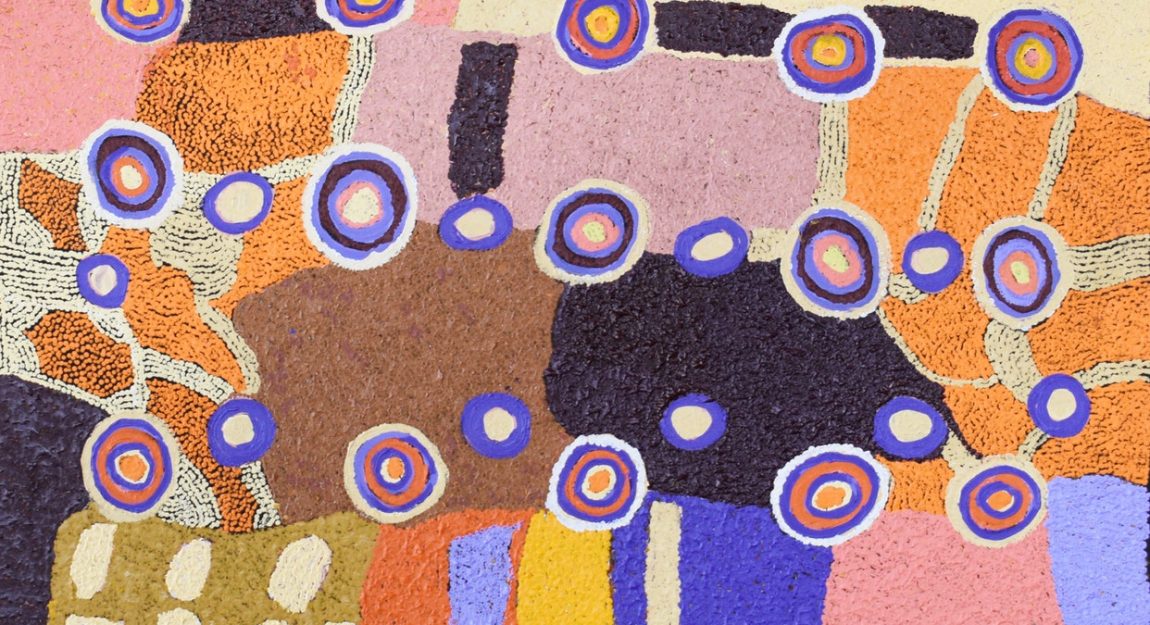10 of the Most Common Aboriginal Art Symbols
Indigenous art uniquely captures the cultural significance of Australia’s First Nations peoples’ sacred storytelling. It portrays the history, beliefs, and survival stories of Aboriginal culture using symbols that vary by region. These symbols, while diverse, consistently show respect for their subjects. Explore the top ten Aboriginal art symbols to delve into the narratives passed down through generations!
Aboriginal Art Symbols #1: The People
Think about the shape you create when you sit cross-legged on the ground. This mark on the earth, a U shape, has come to represent a human in Aboriginal art. The utensils and tools beside the U shape can determine whether the subject is male or female. In the piece below, Berryl Bell depicts the epic Tjukurrpa story of the Seven Sisters.
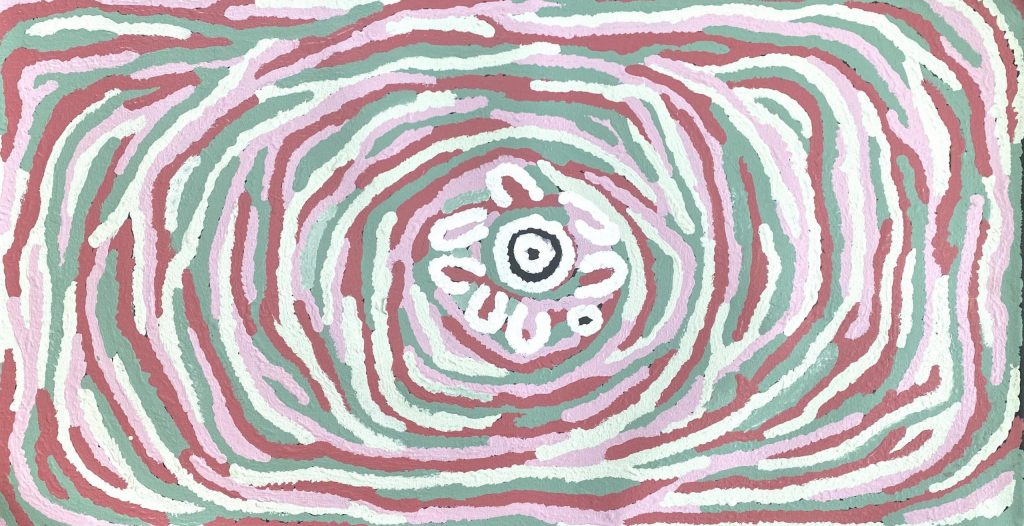
Seven Sisters – Kungkarangkalpa by Berryl Bell.
Aboriginal Art Symbols #2: The Hunter
Deviating from the U shape emerges a symbol depicting a hunter. This symbol is formed from the U-shaped body and is usually accompanied by a line. The line is most commonly the hunter’s spear or similar weapon. In the artwork below, Nenkandoli Lakalinyeri of the Coorong artist Craig Buchanan tells the tale of men hunting kangaroos for food.
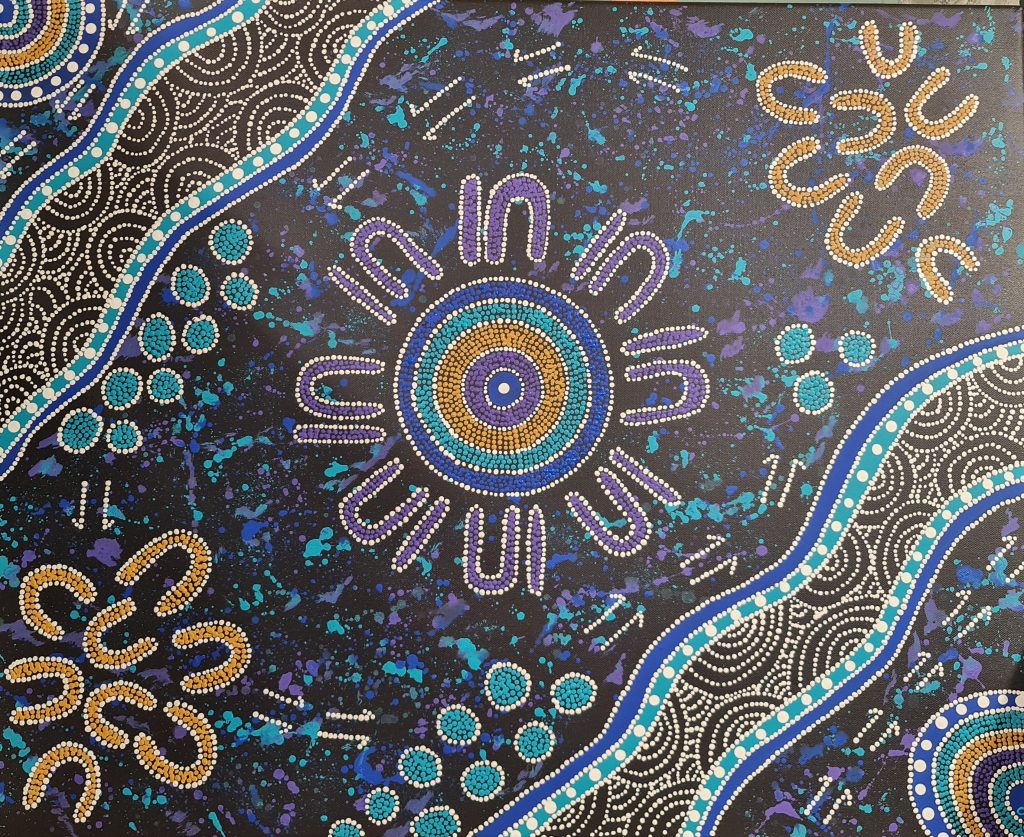
Craig Buchanan’s works are laden with Aboriginal art symbols and show the traditional roles of men and women on the quest to find various types of food.
Aboriginal Art Symbols #3: The Waterhole
It’s easy to overlook the importance of this symbol in Aboriginal art, but the waterhole plays a critical role in desert survival and is paramount in Indigenous artwork. Not only do they occur in stories because of their physical presence in history’s tales, but they are also seen as sacred places and convey how essential they are in the Aboriginal people’s beliefs. Below, ‘fresh water’ woman’ of Wiradyuri people Maria Watson-Trudgett, depicts her country’s various rivers and waterholes.
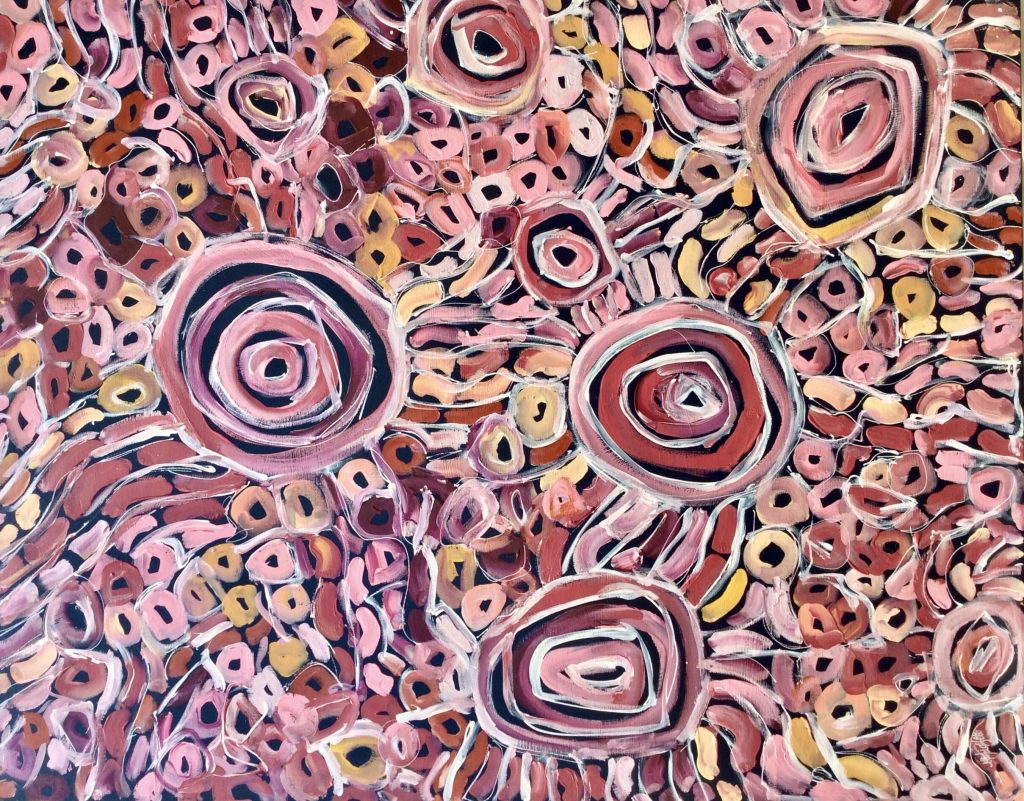
Rivers & Waterholes (Pink) by Maria Watson-Trudgett.
Aboriginal Art Symbols #4: The Flow of Water
It’s not uncommon to see tracks in Aboriginal art depicting running water stemming from waterholes. Since so much of Australia’s outback is dry, arid landscape, running water is a treasure in several communities and a valuable part of Indigenous storytelling. The lines in the artwork can involve the elements of a storm that brings the precious water flow to the dry creek beds – as seen in this piece by Ada Andy Napaltjarri.
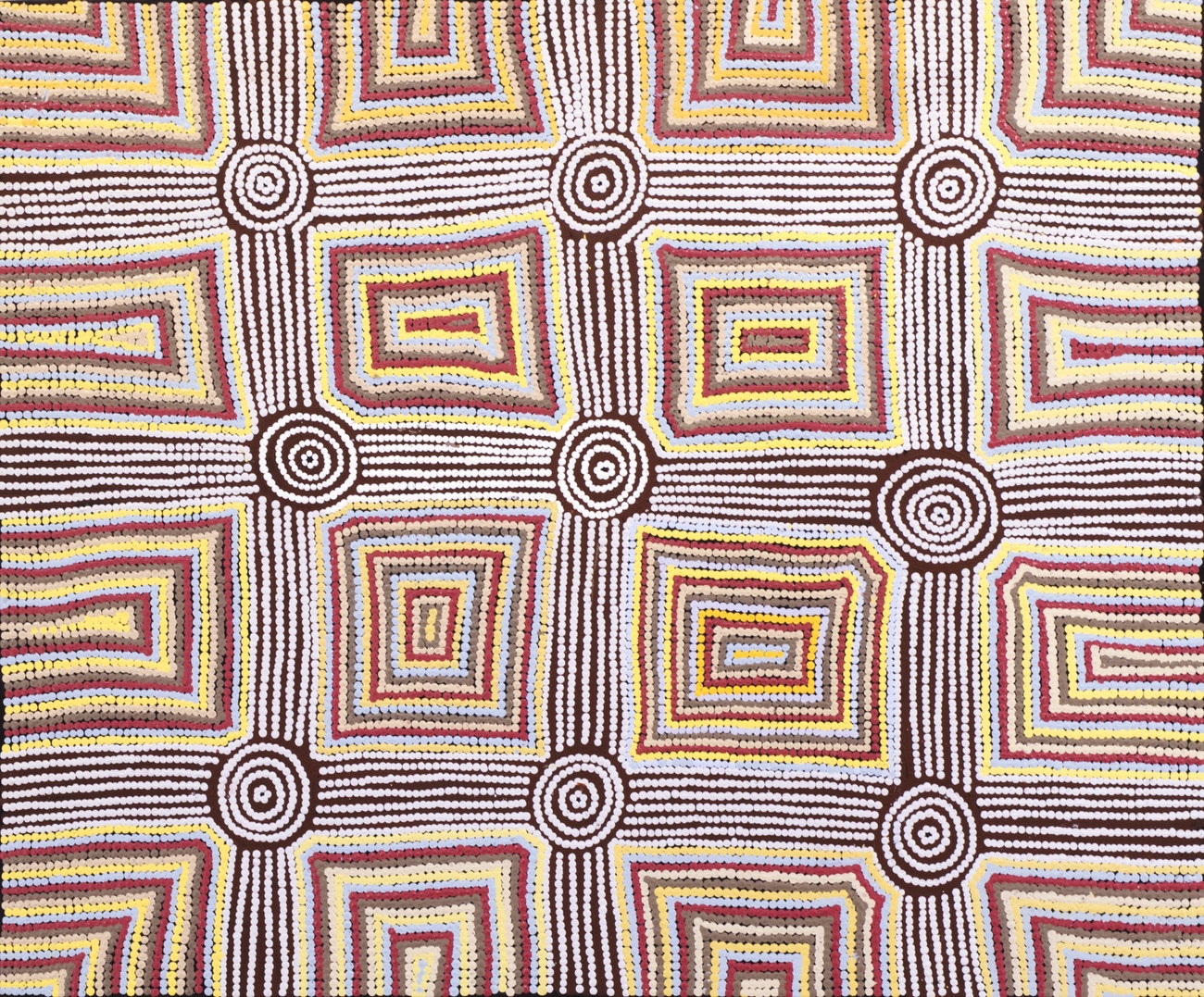
Kapi Tjukurrpa 112-18 by Ada Andy Napaltjarri uses the symbol of flowing water to tell one of the many water dreamtime stories from the Papunya area.
Aboriginal Art Symbols #5: The Goanna
These ancient reptiles are frequent subjects in Aboriginal art since they are significant in Australia’s Indigenous communities. As a traditional source of bush food, goanna paintings come in traditional and contemporary works, and their weight in the artwork depends on the artist and the region they come from. The water goanna in the piece below inhabits the wetlands of the Western Arnhem land, home of the Kunwinjku people. Residents know these monitor lizards and their eggs as a tasty delicacy!
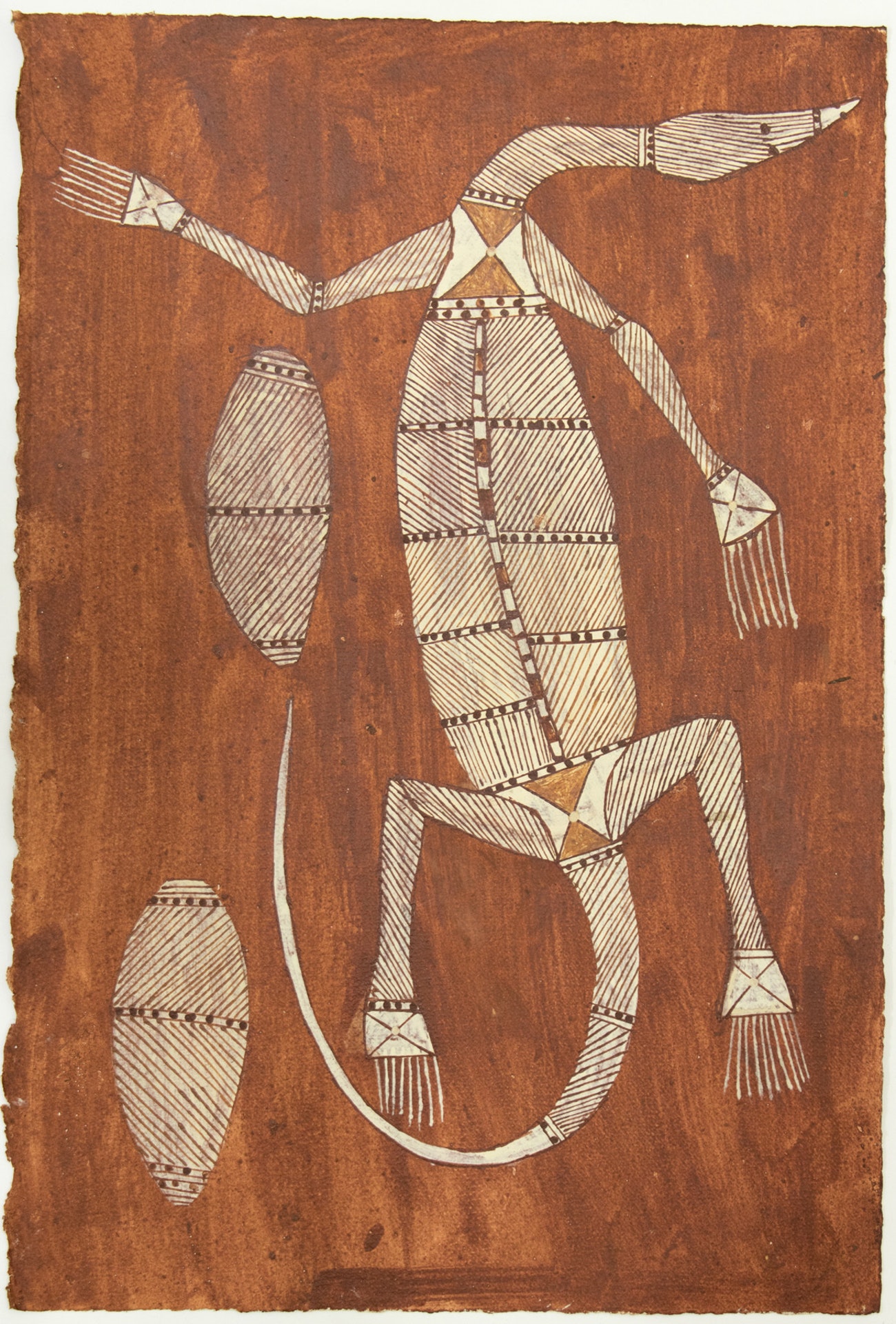
Here, Don Namundja depicts the Burarr, or water goanna, in the signature Kunwinjku’ x-ray’ style. Kunwinjku art is one of the oldest continuous art traditions in the world.
Aboriginal Art Symbols #6: The Snake
From the symbol of strength to the serpent of creation, the snake is a central character in many Aboriginal art stories. Throughout Australia’s indigenous communities, it is respected as a strong force within the animal kingdom. Aboriginal artist Michelle Kickett reflects aspects of the traditional Noongar landscape and culture through her work; here is an example of how the animals local to a region can inspire its Aboriginal inhabitants, as Michelle uses the tiger snake as the core of the piece Noorn Boodjah – Snake Country.
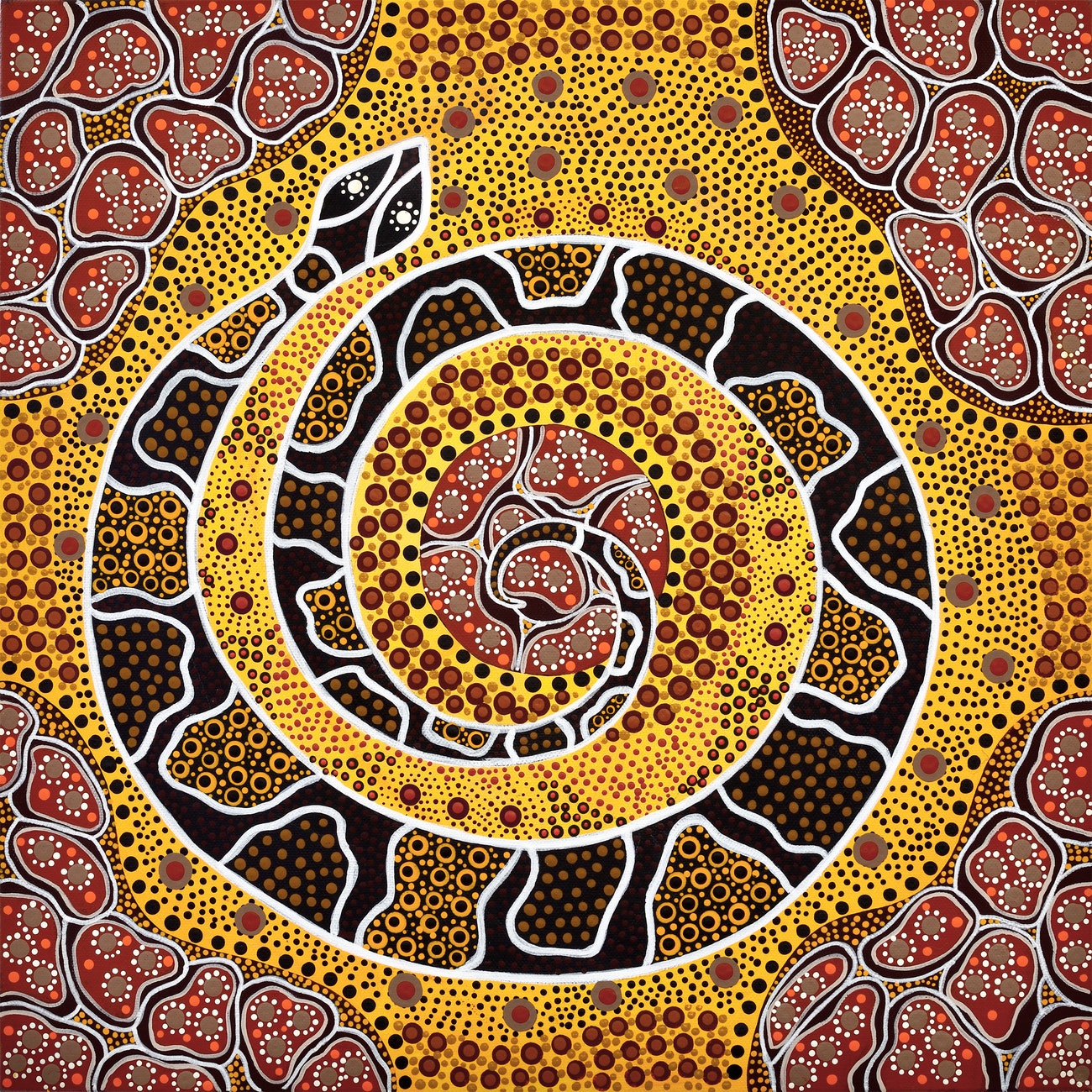
Michelle’ Wilura’ Kickett tells the story of the tiger snake that dwells in southwest Australia as it emerges after hibernation.
Aboriginal Art Symbols #7: The Coolamon
The coolamon is much like the original Aboriginal backpack – its bowl-like, oval shape is primarily used as a gathering tool or a utensil to hold food. Cut from the bark of trees, deep coolamons are typically used to carry water or to rock babies to sleep.
The coolamon is a prominent figure in Aboriginal art and the subject of many stories. After spending years watching her mother and father paint, artist Geraldine Nowee often paints the landscape of the desert region, including the various flowers, seeds, and bush tucker that periodically dominate the dunes throughout the year. Geraldine shows here how coolamons are customarily used to carry seeds in this region.

Geraldine has painted Minyurrpa, her mother’s country, where dots represent an abundance of seeds spread across the landscape; alongside the seeds are the coolamons used to carry them and the dunes that ripple across the desert region.
Aboriginal Art Symbols #8: The Rockhole
Rockholes are another example of a geographical place becoming sacred within Aboriginal storytelling. Rockholes often provide a water source but are also a prime spot for spiritual and cultural ceremonies. In much of the country, Aboriginal communities relate the rockholes of the region with their own local stories. For instance, Pukara Rock Hole in this artwork by Jimmy Donegan is a Mecca for the region’s stories. One can learn the lay of the land and stories of battle and disputes, injury and recovery, seasonal flora, resources, and water – all waiting to be found at Pukara.
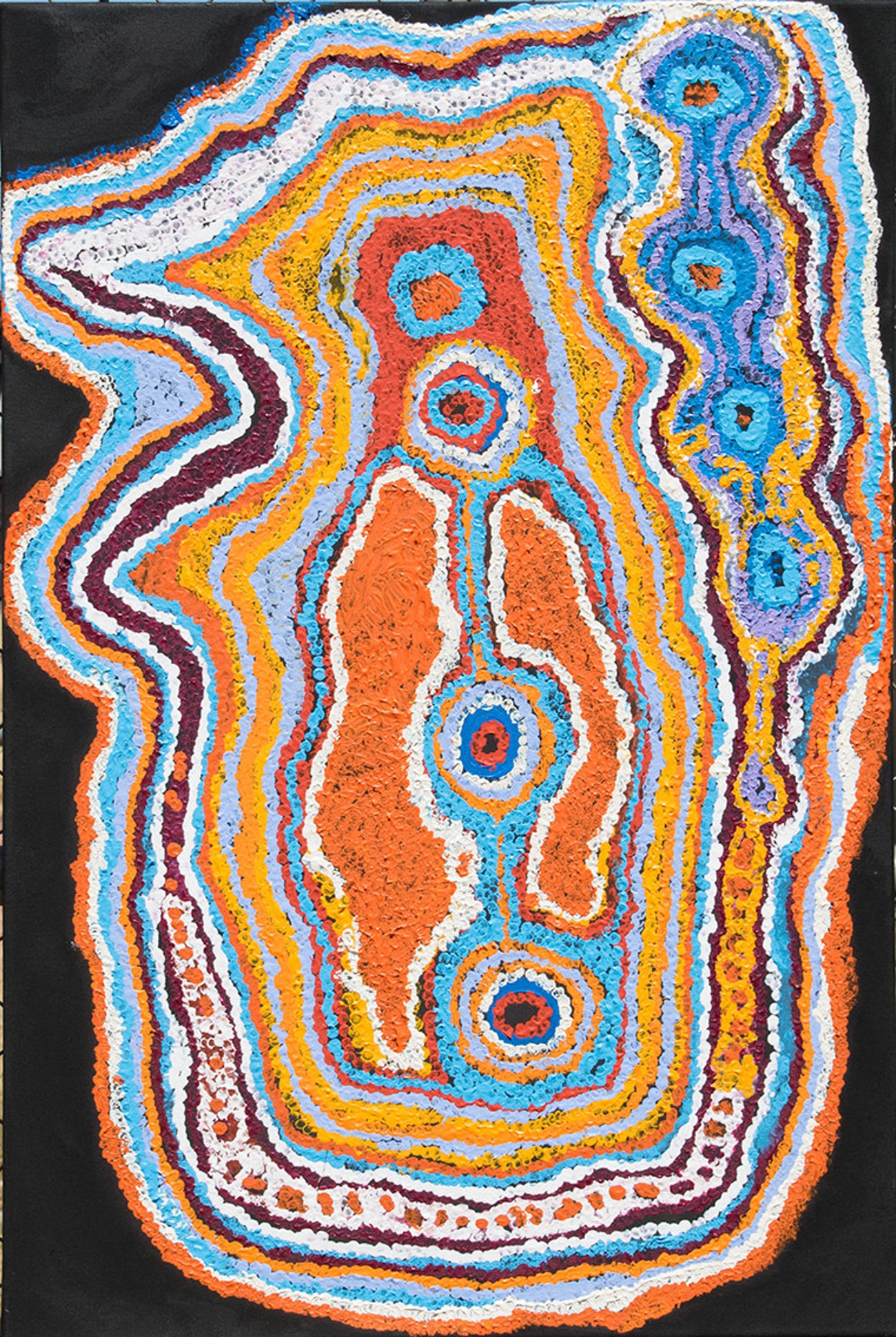
Based on a prominent Aboriginal art symbol, the stories attached to the Pukara Rock Hole are plentiful. Jimmy Donegan attributes this piece to the rock hole and its renowned stories within his country.
Aboriginal Art Symbols #9: The Mimih Spirit
Legend states that Mimihs were the original spirit beings and taught Aboriginal people many skills to survive in the bush, along with ceremonies, dance, and song. According to the Kunwinjku people of western Arnhem Land, the mimic spirits are seldom seen by human eyes but continue to reside in rocks, trees, and caves. In the rock art of Arnhem land, these spirits are depicted as small yet dynamic symbols with hunting weapons. Several artists of the Injalak Art Centre tell the stories of mimih spirits through their art, such as this piece by Michael Naborlhborlh.

Michael Naborlhborlh brings the Arnhem land to the viewer in this piece, Mimih Spirit Hunting 6773-18
Aboriginal Art Symbols #10: Bush Tucker
Food is at the heart of every culture, and Aboriginal stories are no exception! Bush onions, potatoes, tomatoes, bananas – all bush tucker waiting to be gathered and grazed on! This food is native to Australia and is part of the culinary delights of Aboriginal Australian people. It is commonly represented by symbols of flora and fauna, usually with branches and berries, as seen in this artwork by Carol Kenny.

Ladies (Coongas) Going Hunting for Bush Tucker by Carole Kenny shows the U-shaped females with their coolamons, ready to find an abundance of bush tucker!
Shop Ethical Aboriginal Art Today
One of Bluethumb’s primary focuses is supporting Indigenous artists and remote Australian art centers. As a proud Indigenous Art Code member, we always seek opportunities to promote Aboriginal artists’ talents and customs.
These Aboriginal art symbols are fundamental to preserving the culture of the communities from which they originate. Knowledge of these symbols must be disseminated to strengthen Aboriginal culture and art.
Bluethumb is proud to support diverse artists. Shop ethical Indigenous art on Bluethumb today.

